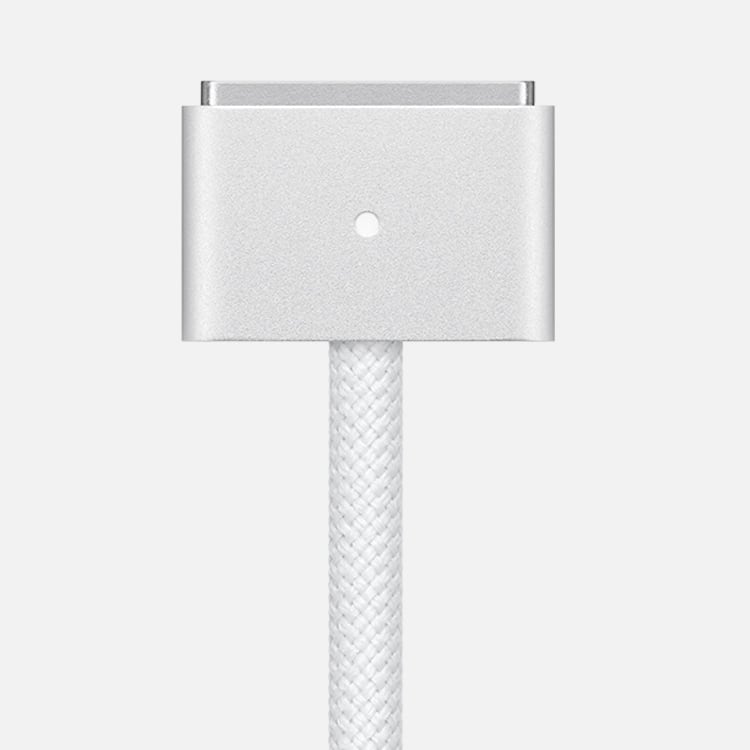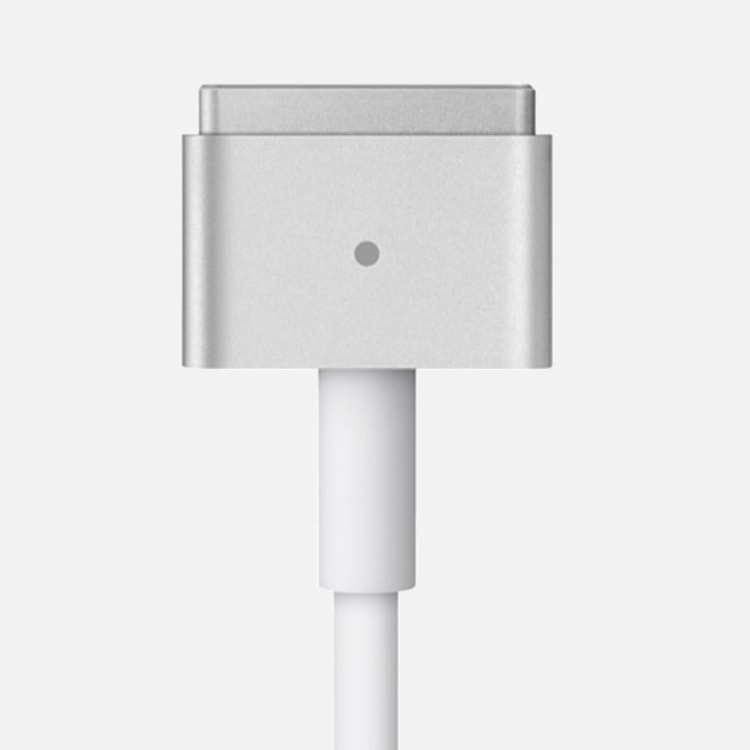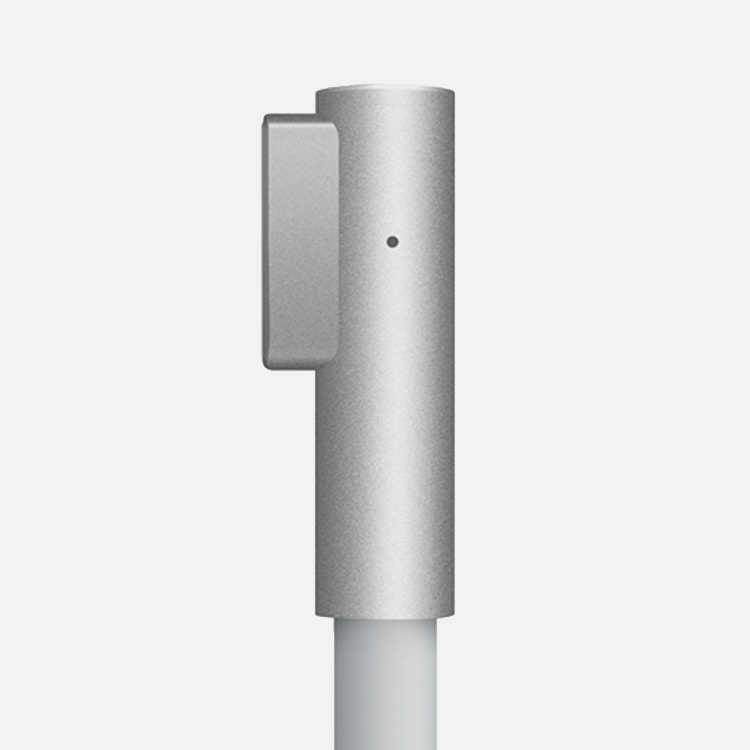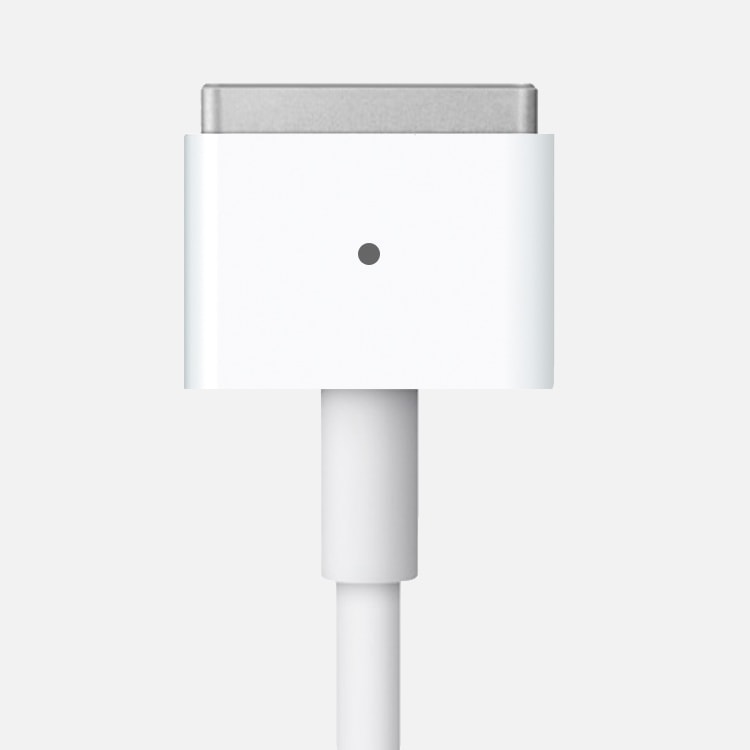Identify your MagSafe cable or adaptor
If your Mac uses MagSafe to charge the battery, it will use either a MagSafe 3 connector, MagSafe 2 connector, or a T-style or L-style MagSafe connector. To identify your cable or adaptor, use the list below to find your MagSafe connector.

MagSafe 3 connector

MagSafe 2 connector

L-style MagSafe connector

T-style MagSafe connector
If your Mac uses MagSafe 3, you can charge your Mac with a USB-C to MagSafe 3 Cable and a USB-C power adaptor.
If your Mac uses MagSafe 2, you can charge your Mac with a MagSafe 2 power adaptor or a MagSafe power adaptor connected with the MagSafe to MagSafe 2 converter.
If your Mac uses MagSafe, you can charge your Mac with a T-style or L-style MagSafe power adaptor.
The MagSafe connector and MagSafe port on your Mac laptop contain a magnet that can possibly erase data on a credit card or other magnetic devices. Keep magnetic media away from the end of the MagSafe adaptor and away from the MagSafe port.
MagSafe 2 and MagSafe power adaptors aren't compatible with MagSafe 3.
Check the power
Find out how to check your plug socket and confirm your adaptor wattage.
Check the plug socket
Make sure that you've connected your power adaptor to a working plug socket. Unplug your power adaptor from the plug socket, then plug in a known-good device, such as a lamp or clock, to confirm that it turns on correctly. If the plug socket is working, connect your power adaptor and try charging your Mac. If your Mac still isn't charging, shut it down and close the display for 30 seconds, then open the display and try charging it again. If you have an Intel-based Mac, reset the SMC.
Confirm the adaptor wattage
Make sure the correct wattage power adaptor for your laptop is being used. For the best charging experience, you should use the power adaptor and cable included with your Mac laptop.
Check for line noise issues
Unplug the power adaptor from the wall, wait 60 seconds and then plug the adaptor back in.
- If the adaptor works after this 60 second "rest", it's most likely that you have a line noise issue with your power source. You should reset the adaptor periodically by repeating this moment of rest. This issue occurs when the AC adaptor's over-voltage protection feature senses ground noise and then turns off the adaptor.
- Some possible sources of line noise include lights with ballasts, refrigerators or mini-refrigerators that are on the same electrical circuit as your computer. This behaviour may not occur if you plug the power adaptor into an uninterruptible power supply (UPS) or plug it into a different circuit.
If your power adaptor continues to turn itself off when connected to a known-good socket, take your adaptor to an Apple Authorised Service Provider or Apple Store for further evaluation.
If you see a spark
Sometimes when you plug the power adaptor into a wall plug socket, you may see a spark. This is usually normal and can occur when you plug any electrical appliance into a live socket. If the spark comes from somewhere other than the blades of the plug, if you experience any damage or discolouration of the adaptor, or if you have other concerns about sparking, contact Apple.
Check the plug, power port and MagSafe connector or cable
Find out how to test the AC plug or cable, inspect the power port and check for damage.
Check the AC plug or cable
Your power adaptor comes with a removable AC plug that has the blades for inserting into a plug socket. If your Mac laptop won't charge when using the AC plug with the power adaptor, try it with another Apple AC plug, or try using an Apple Power Adaptor Extension Cable (sold separately).
If your power adaptor works after changing the AC plug or AC cord, the AC plug or AC cord that you were originally using should be replaced and no longer used.
Check the power port for debris
Make sure that the power port (where you plug in the MagSafe connector) is clean and free of debris. The port is magnetic and may attract metal objects.
If the indicator light flashes
If your battery is charging or charging is on hold, the indicator light will glow amber. If the indicator light on the MagSafe 3 connector flashes amber repeatedly, try these steps:
- Disconnect the USB-C to MagSafe 3 Cable from your Mac and from the power adaptor.
- Disconnect the USB-C power adaptor from the plug socket.
- Use a dry cloth to wipe the MagSafe 3 port and MagSafe 3 connector. Make sure both the port and connector are dry and clear of any debris.
- Make sure the USB-C port on the power adaptor and the USB-C connector are clear of any debris.
- Restart your Mac.
- Connect the USB-C power adaptor to the wall socket, connect the USB-C to MagSafe 3 Cable to the power adaptor and to your Mac, then try charging again.
If the indicator light continues to flash repeatedly, contact Apple.
Check for strain relief (MagSafe 2 or earlier)
If your DC cable (the thin cord that attaches the MagSafe 2 or MagSafe connector to the power adaptor) separates at either end of the cable, immediately stop using the cable and get your cable and power supply evaluated.
If the adaptor starts getting warm
The power adaptor can become warm during normal use so make sure that you use it in a well-ventilated area. Always plug the power adaptor directly into a plug socket using the AC plug, or place it on a table or other well-ventilated area.
Avoid placing your adaptor in a poorly ventilated area, such as on a sofa, thick carpet, bedding or a pillow. Avoid covering the adaptor with a blanket or other insulation.
The power adaptor may turn itself off if it gets too warm. If this happens, disconnect the MagSafe connector from your Mac laptop, then let the power adaptor cool down before handling it.
Check for updates
In some cases, software or firmware updates may be available for your computer that will improve communication with your power adaptor. If your MacBook, MacBook Air or MacBook Pro isn't charging as expected, check for software updates on your Mac.
Arrange a service or purchase a new cable or adaptor
If your cable or power adaptor still isn't working, you can bring it and your Mac laptop to an Apple Store or Apple Authorised Service Provider for evaluation.
If you want to purchase a replacement, choose your cable or power adaptor below:
- Apple USB-C to MagSafe 3 Cable (2m) for Mac laptops introduced in 2021 or later
- Apple 140W USB-C Power Adaptor for 16-inch MacBook Pro (2021 or later)
- Apple 70W USB-C Power Adaptor for 14-inch MacBook Pro or MacBook Air (2022 or later)
- Apple 35W Dual USB-C Port Compact Power Adaptor for MacBook Air (2022 or later)
- Apple 30W USB-C Power Adaptor for MacBook Air (2018 or later)
- Apple 45W MagSafe 2 Power Adaptor for MacBook Air
- Apple 60W MagSafe 2 Power Adaptor (MacBook Pro with 13-inch Retina display)
- Apple 85W MagSafe 2 Power Adaptor (for MacBook Pro with Retina display)
- Apple 45W MagSafe Power Adaptor for MacBook Air
- Apple 60W MagSafe Power Adaptor (for MacBook and 13-inch MacBook Pro)
- Apple 85W MagSafe Power Adaptor (for 15- and 17-inch MacBook Pro)
If you're not sure which cable or power adaptor to use with your Mac, find out how to identify your Mac power adaptor.